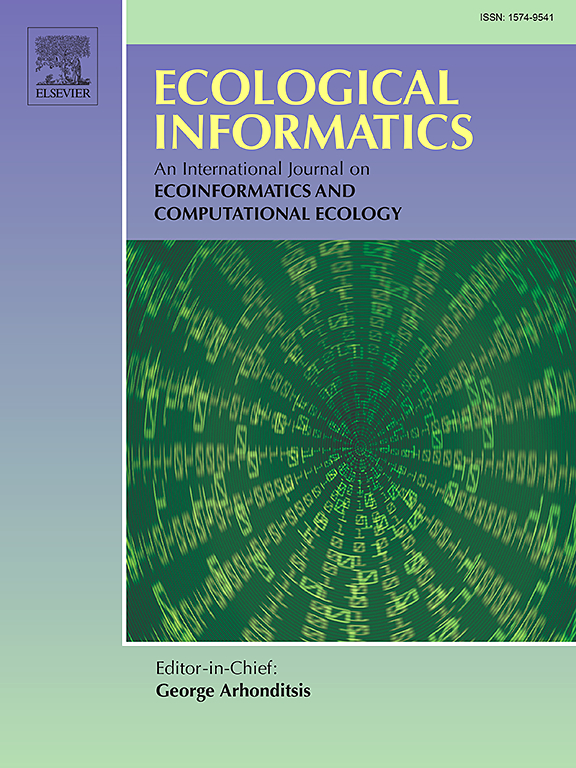Seasonal and inter-annual dynamics of a Macrocystis pyrifera forest in Concepcion Bay, Chile
IF 5.8
2区 环境科学与生态学
Q1 ECOLOGY
引用次数: 0
Abstract
Kelp forest are foundation species that deliver key ecosystem services for coastal habitats. Chile is one of the largest exporters of kelp biomass, which relies on the harvesting of wild populations. The vast and rugged coastline of Chile hinders field-based studies of the seasonal and spatial dynamics of kelp biomass, yet remote sensing approaches can provide an effective tool to study temporal patterns of kelp distribution and biomass. Our study aimed to establish the basic patterns of variation in the surface area and biomass of a Macrocystis pyrifera forest off Concepcion Bay, Central Chile. Using archival data from the Landsat series we constructed a long-term series of annual kelp canopy cover and assessed patterns of interannual, and a seasonal variation with the more recent Sentinel 2 data using Google Earth Engine. We validated satellite observations of the kelp forest in the field by recording local temperature and nutrient concentrations and through a sample of blades and stipes, which we used to estimate whole-individual in situ biomass through allometric relationships. Finally, we related decadal to interannual changes in canopy cover to local and regional drivers using data from public repositories. Our 24-year annual time series revealed large year-to-year variability in kelp forest area that did not show a significant association with different El Niño-Southern Oscillation indices, but the deviance explained increased notably with a 1-year lag. The seasonal time series exhibited clear seasonal patterns with cover peaking during summer. We found a significant influence of local environmental variables such as temperature, wave height, nitrate concentration, and solar radiation on kelp forest area. Furthermore, blade counts appeared as the most reliable metric for estimating M. pyrifera biomass. Interestingly, we found no evidence of temperature or nutrient stress during the summer biomass peak, hence seasonal variation in M. pyrifera abundance appears to be primarily influenced by solar radiation and wave activity in our study population. Our results provide a basis to derive seasonal time series across Chile’s kelp forests and suggest that understanding local stressors is key to ensure harvesting practices that promote the sustainable management of these key habitats. As ongoing climate change and overexploitation threaten kelp forest habitats, remote sensing emerges as a promising tool for the monitoring and management of extensive and remote coastlines.
智利康塞普西翁湾大囊藻(Macrocystis pyrifera)森林季节和年际动态
海带林是为沿海生境提供关键生态系统服务的基础物种。智利是最大的海带生物量出口国之一,这依赖于野生种群的收获。智利广阔而崎岖的海岸线阻碍了海带生物量季节性和空间动态的实地研究,但遥感方法可以为研究海带分布和生物量的时间模式提供有效工具。本研究旨在建立智利中部康塞普西翁湾(Concepcion Bay)外大孢子藻(Macrocystis pyrifera)森林表面积和生物量变化的基本模式。利用Landsat系列的存档数据,我们构建了一个长期的海带年冠层覆盖序列,并利用谷歌Earth Engine利用Sentinel 2最近的数据评估了年际和季节变化模式。我们通过记录当地温度和营养浓度,并通过叶片和茎杆样本验证了卫星观测的现场海带森林,我们使用叶片和茎杆样本通过异速生长关系来估计整个个体的原位生物量。最后,我们利用来自公共数据库的数据,将树冠覆盖度的年代际变化与本地和区域驱动因素联系起来。我们的24年年度时间序列显示,海带森林面积的年际变化很大,与不同的El Niño-Southern振荡指数没有显著的关联,但偏差在1年的滞后期显著增加。季节时间序列表现出明显的季节特征,覆盖度在夏季达到峰值。温度、波高、硝态氮浓度、太阳辐射等局部环境变量对海带森林面积有显著影响。此外,叶片数量似乎是估算硫胺素生物量最可靠的指标。有趣的是,在夏季生物量高峰期间,我们没有发现温度或营养胁迫的证据,因此,在我们的研究群体中,M. pyrifera丰度的季节变化似乎主要受太阳辐射和波浪活动的影响。我们的研究结果为推导智利海带森林的季节性时间序列提供了基础,并表明了解当地的压力源是确保采伐实践促进这些关键栖息地可持续管理的关键。随着持续的气候变化和过度开发威胁到海带林栖息地,遥感成为监测和管理广阔而偏远海岸线的一种有前途的工具。
本文章由计算机程序翻译,如有差异,请以英文原文为准。
求助全文
约1分钟内获得全文
求助全文
来源期刊

Ecological Informatics
环境科学-生态学
CiteScore
8.30
自引率
11.80%
发文量
346
审稿时长
46 days
期刊介绍:
The journal Ecological Informatics is devoted to the publication of high quality, peer-reviewed articles on all aspects of computational ecology, data science and biogeography. The scope of the journal takes into account the data-intensive nature of ecology, the growing capacity of information technology to access, harness and leverage complex data as well as the critical need for informing sustainable management in view of global environmental and climate change.
The nature of the journal is interdisciplinary at the crossover between ecology and informatics. It focuses on novel concepts and techniques for image- and genome-based monitoring and interpretation, sensor- and multimedia-based data acquisition, internet-based data archiving and sharing, data assimilation, modelling and prediction of ecological data.
 求助内容:
求助内容: 应助结果提醒方式:
应助结果提醒方式:


